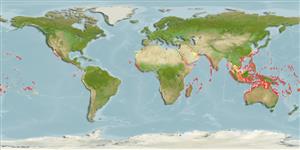Common names from other countries
Environment: milieu / climate zone / depth range / distribution range
ນິເວດວິທະຍາ
ສັດທະເລ ກ່ຽວກັນຫີນ; ລະດັບຄວາມເລິກ 0 - 50 m (Ref. 7348). Tropical; 30°N - 30°S
Indo-Pacific: East Africa eastward through northern Australia to Hawaiian, Marquesas and Tuamotu islands, north to southern Japan.
Length at first maturity / ຂະໜາດ / ນ້ຳໜັກ / Age
Maturity: Lm 14.0 range ? - ? cm
Max length : 30.0 cm TL ຕົວຜູ້/ບໍ່ມີເພດ; (Ref. 4420); common length : 15.0 cm TL ຕົວຜູ້/ບໍ່ມີເພດ; (Ref. 5450)
ຄີ (ໜາມ)ແຂງຢູ່ຫຼັງປາ (ທັງໝົດ) : 3; ຄີຫຼັງຂອງປາ (ຄີອ່ອນ) (ທັງໝົດ) : 23 - 26; ຄີ(ໜາມ) ແຂງຢູ່ຄີກົ້ນປາ
ກຸ່ມປາກະດູກແຂງ
ຄວາມຖີ່ຂອງກຸ່ມຖ່າຍທອດພັນ
ປາທີ່ມີການເຄື່ອນຍ້າຍຈາກທະເລໄປຫານ້ຳຈືດ ແລະນ້ຳຈືດຫາທະເລ
ປາທີ່ມີການເຄື່ອນຍ້າຍຈາກທະເລແລະໄປໄຂ່ຢູ່ນ້ຳຈືດ
ຄີກົ້ນຂອງປາ
ສັດທີ່ມີກະດູກສັນຫັຼງ
ການຖ່າຍທອດທາງກຳມະພັນຈາກພໍ່ແມ່ຫາລູກ: 0; ຄີກົ້ນຂອງປາ: 21 - 23.
Commonly found in subtidal reef flats and shallow protected lagoons, Ref. 48637. Benthopelagic (Ref. 58302). Juveniles secretive with rubble patches, adults swim about openly but are usually shy (Ref. 48637). Territorial. Feed on algae, detritus, mollusks, crustaceans, worms, sea urchins, fishes, corals, tunicates, forams, and eggs (Ref. 3921). Oviparous (Ref. 205). Sleep on its side; makes a whirring noise when alarmed (Ref. 4420). Also caught with drive-in nets and is considered a popular aquarium fish (Ref. 9770).
Life cycle and mating behavior
Maturities | ການສືບພັນ | Spawnings | Egg(s) | Fecundities | ຕົວອ່ອນ
Distinct pairing (Ref. 205). Mating system may be a mixture of polygyny, monogamy, and potential promiscuity in solitary females but the primary mating system considered for this species is polygyny (Ref. 116439). Females are territorial, solely tending and guarding the eggs (Ref. 116451). Males exhibit polygyny (Ref. 116451).
Myers, R.F., 1991. Micronesian reef fishes. Second Ed. Coral Graphics, Barrigada, Guam. 298 p. (Ref. 1602)
IUCN Red List Status (Ref. 130435)
CITES (Ref. 128078)
Not Evaluated
Threat to humans
Reports of ciguatera poisoning (Ref. 130160)
Human uses
ການປະມົງ: ທີ່ເປັນການຄ້າໜ້ອຍ; ຕູ້ປາ: ເປັນສີນຄ້າ
ເຄື່ອງມື
Special reports
Download XML
ແຫຼ່ງອີນເຕີເນັດ
Estimates based on models
Preferred temperature (Ref.
115969): 24.5 - 29, mean 27.7 (based on 1010 cells).
Phylogenetic diversity index (Ref.
82804): PD
50 = 0.5078 [Uniqueness, from 0.5 = low to 2.0 = high].
Bayesian length-weight: a=0.01905 (0.01109 - 0.03275), b=2.93 (2.78 - 3.08), in cm Total Length, based on LWR estimates for this species & (Sub)family-body (Ref.
93245).
ຊັ້ນເຂດຮ້ອນ (Ref.
69278): 3.2 ±0.1 se; based on diet studies.
ຄວາມຢືດຢຸ່ນ (Ref.
120179): ສູງ, ປະຊາກອນຕຳ່ສຸດທີ່ໃຊ້ເວລາສອງໜ້ອຍກວ່າ 15 ເດືອນ (K=0.4).
Fishing Vulnerability (Ref.
59153): Low to moderate vulnerability (30 of 100).
